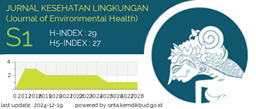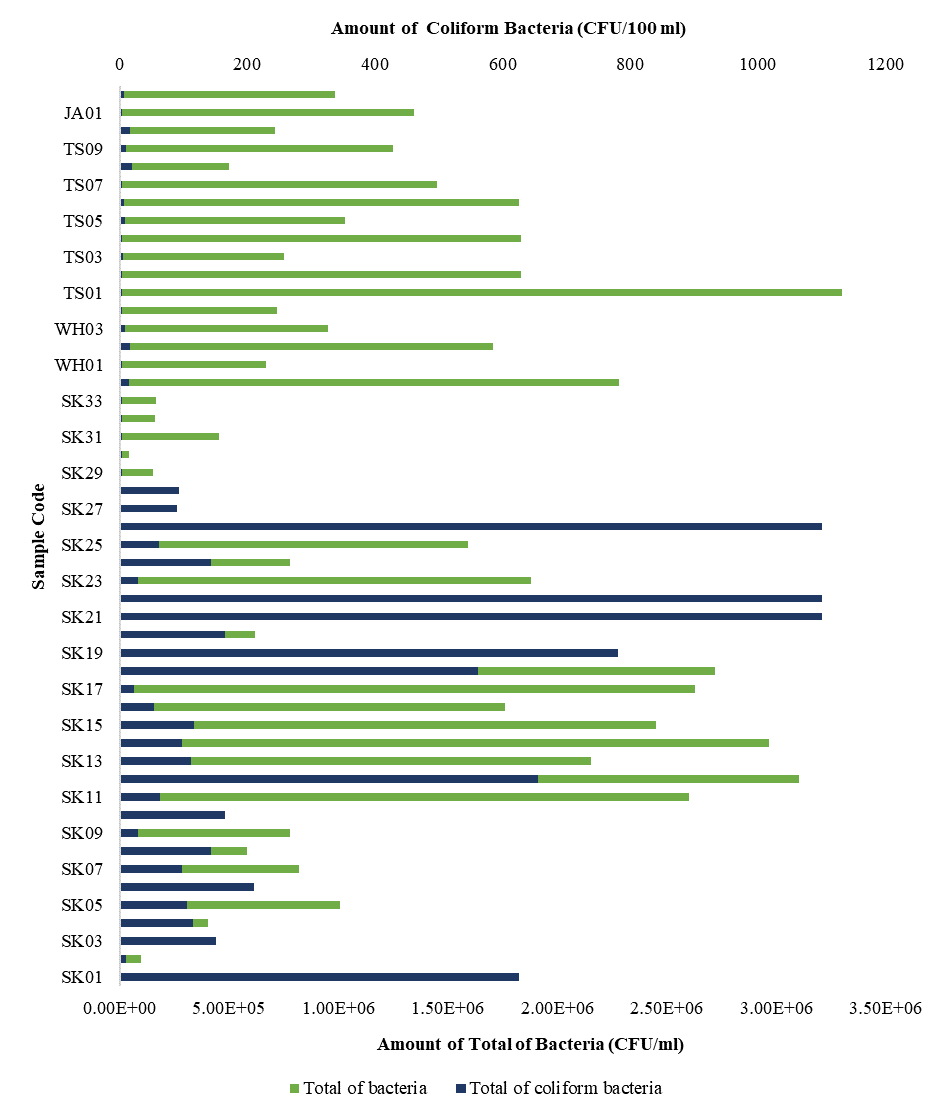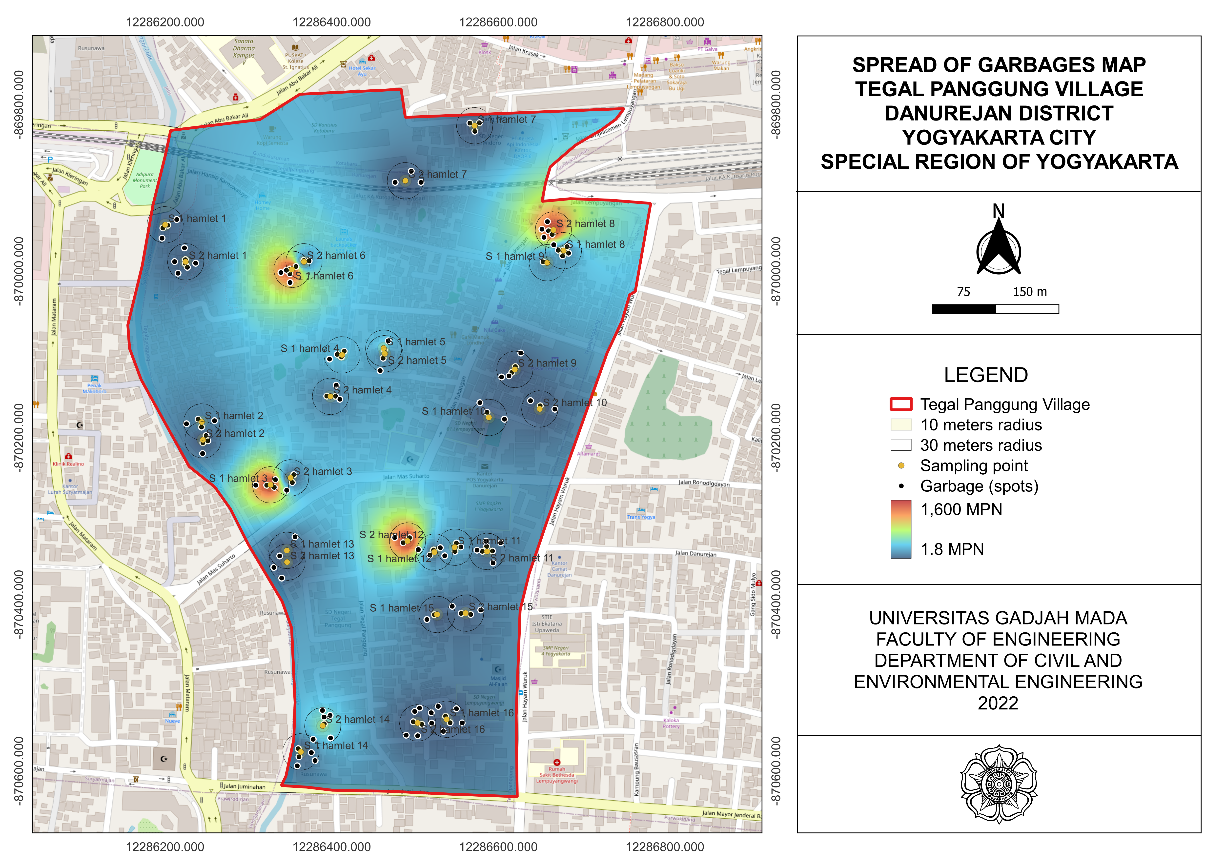Profiling the Inequality of School Water, Sanitation, and Hygiene Facilities Among Indonesian Regions Using Cluster Analysis

Introduction: Humans rely heavily on Water, Sanitation, and Hygiene (WASH) facilities. Goal 6 of the Sustainable Development Goals (SDGs) emphasizes ensuring communities possess universal access to clean water and sanitation. Because WASH is tremendously crucial in schools, the objective of this study is to provide a comprehensive profile of regional inequalities based on the availability of WASH indicators through cluster analysis. Methods: This study administered cross-sectional data from 514 regencies/cities in Indonesia with three variables, i.e. percentage of access to water, sanitation, and hygiene at public and private elementary schools. The profiling was performed by conducting K-means clustering method. Results and Discussion: Public and private schools were examined separately as the p-value in the difference test was less than 0.05. In accordance with the silhouette plot, the optimal number of clusters was two for each category. For the public-school category, the number of regencies/cities in Cluster 1 was 380 regencies/cities and 134 regencies/cities were in Cluster 2. For the private school category, Cluster 1 incorporated 418 regencies/cities and Cluster 2 merely encompassed 96 regencies/cities. Conclusion: Two clusters for each type of school had been established with Cluster 1 consisting of areas with high availability of WASH facilities while areas in Cluster 2 possessed a relatively low percentage in the three WASH indicators. There were 66 regencies/cities, generally located in eastern Indonesian provinces, grouped in Cluster 2 for both types of schools.
Deshpande A, Miller-Petrie MK, Lindstedt PA, Baumann MM, Johnson KB, Blacker BF, et al. Mapping Geographical Inequalities in Access to Drinking Water and Sanitation Facilities in Low-Income and Middle-Income Countries, 2000–17. The Lancet Global Health. 2020 Sep;8(9):e1162–e1185. https://doi.org/10.1016/S2214-109X(20)30278-3
World Health Organization. Water, sanitation, hygiene and health: A Primer for Health Professionals. Geneva: World Health Organization; 2019. https://apps.who.int/iris/bitstream/handle/10665/330100/WHO-CED-PHE-WSH-19.149-eng.pdf
World Health Organization. Safer Water, Better Health. Geneva: World Health Organization; 2019. https://www.who.int/publications/i/item/9789241516891
United Nations International Children's Emergency Fund. Drinking Water, Sanitation and Hygiene in Schools: Global Baseline Report 2018. Geneva: United Nations International Children's Emergency Fund; 2018. https://data.unicef.org/wp-content/uploads/2018/08/JMP-WASH-in-Schools-WEB.pdf
Ministry of Education, Culture, Research, and Technology of the Republic of Indonesia. Sanitation Profile of School in 2020. Jakarta: Ministry of Education, Culture, Research, and Technology of the Republic of Indonesia; 2020.
Cronk R, Guo A, Fleming L, Bartram J. Factors Associated with Water Quality, Sanitation, and Hygiene in Rural Schools in 14 Low- and Middle-Income Countries. Science of The Total Environment. 2021;761(144226):1-11. https://doi.org/10.1016/j.scitotenv.2020.144226
Vally H, McMichael C, Doherty C, Li X, Guevarra G, Tobias P. The Impact of a School-Based Water, Sanitation and Hygiene Intervention on Knowledge, Practices, and Diarrhoea Rates in the Philippines. IJERPH. 2019;16(21):4056. https://doi.org/10.3390/ijerph16214056
McMichael C. Water, Sanitation and Hygiene (WASH) in Schools in Low-Income Countries: A Review of Evidence of Impact. IJERPH. 2019;16(3):359. https://doi.org/10.3390/ijerph16030359
Lekan-Agunbiade T, Onayade A, Agunbiade O. Knowledge of Diarrhoeal Diseases and Hygiene Practices of In-School Adolescents. Fortune J Health Sci. 2021;4(3). https://doi.org/10.26502/fjhs.030
Wolf J, Hubbard S, Brauer M, Ambelu A, Arnold BF, Bain R, et al. Effectiveness of Interventions to Improve Drinking Water, Sanitation, and Handwashing With Soap on Risk of Diarrhoeal Disease in Children in Low-Income and Middle-Income Settings: A Systematic Review and Meta-Analysis. The Lancet. 2022;400(10345):48–59. https://doi.org/10.1016/S0140-6736(22)00937-0
Arifin H, Rakhmawati W, Kurniawati Y, Pradipta RO, Efendi F, Gusmaniarti G, et al. Prevalence and Determinants of Diarrhea Among Under-Five Children in Five Southeast Asian Countries: Evidence from the Demographic Health Survey. Journal of Pediatric Nursing. 2022;66(1):e37–e45. https://doi.org/10.1016/j.pedn.2022.06.005
Gebrehiwot T, Geberemariyam B, Gebretsadik T, Gebresilassie A. Prevalence of Diarrheal Diseases Among Schools with and without Water, Sanitation and Hygiene Programs in Rural Communities of North-Eastern Ethiopia: A Comparative Cross-Sectional Study. RRH. 2020;20(4):4907. https://doi.org/10.22605/RRH4907
Ohwo O. Status of Water, Sanitation and Hygiene Facilities in Public Secondary Schools in Yenagoa, Nigeria. World Journal of Social Sciences and Humanities. 2019;5(3):176–183. https://doi.org/10.12691/WJSSH-5-3-7
Vilcins D, Sly PD, Jagals P. Environmental Risk Factors Associated with Child Stunting: A Systematic Review of the Literature. Annals of Global Health. 2018;84(4):551. https://doi.org/10.29024/aogh.2361
Xia Y. Correlation and Association Analyses in Microbiome Study Integrating Multiomics in Health and Disease. In: Progress in Molecular Biology and Translational Science. Progress in Molecular Biology and Translational Science. 2020;171(1):309–491. https://doi.org/10.1016/bs.pmbts.2020.04.003
Pérez-Ortega J, Almanza-Ortega NN, Romero D. Balancing Effort and Benefit of K-means Clustering Algorithms in Big Data Realms. PLoS ONE. 2018;13(9):e0201874. https://doi.org/10.1371/journal.pone.0201874
Tan PN, Steinbach M, Karpatne A, Kumar V. Introduction to Data Mining. Second Edition. New York: Pearson; 2019. 839 p.
Oti EU, Olusola MO, Eze FC, Enogwe SU. Comprehensive Review of K-Means Clustering Algorithms. Int J Advanc Sci Res Eng. 2021;7(8):64–69. https://doi.org/10.31695/IJASRE.2021.34050
Kaoungku N, Suksut K, Chanklan R, Kerdprasop K, Kerdprasop N. The Silhouette Width Criterion for Clustering and Association Mining to Select Image Features. Int J Mach Learn. 2018;8(1):69–73. https://doi.org/10.18178/ijmlc.2018.8.1.665
Dini SK, Fauzan A. Clustering Provinces in Indonesia based on Community Welfare Indicators. EKSAKTA: J Sci Data Anal. 2020;1(1):56–63. https://doi.org/10.20885/EKSAKTA.vol1.iss1.art9
Tambunan F. Implementation of Data Mining using the Clustering Method (Case: Region of the Actors of Theft Crime by Province). Int J Sys Tech. 2019;2(2):75-82. https://doi.org/10.30645/ijistech.v2i2.25
Rahmatika Y, Sediyono E, Widodo CE. Implementation of K-Means Clustering and Weighted Products in Determining Crime-Prone Locations. KINETIK. 2020;5(3):195–202. https://doi.org/10.22219/kinetik.v5i3.1067
Damanik NAS, Irianto I, Dahriansah D. Penerapan Metode Clustering Dengan Algoritma K-Means Tindak Kejahatan Pencurian di Kabupaten Asahan. J-Com. 2021;1(1):7–14. https://doi.org/10.33330/j-com.v1i1.1065
Yudhana EF, Siwiendrayanti A. Readiness of Water Sanitation and Hygiene Facilities (WASH) as an Effort to Prevent Covid19 Transmission in Elementary Schools at Ngaliyan District, Semarang City. Journal of Public Health for Tropical and Coastal Region. 2022;5(1):42–50. https://doi.org/10.14710/jphtcr.v5i1.13688
Batool F, Hennig C. Clustering with the Average Silhouette Width. Computational Statistics & Data Analysis. 2021;158(107190):1-18. https://doi.org/10.1016/j.csda.2021.107190
UN-Water. Summary Progress Update 2021: SDG - 6 Water and Sanitation for All. Geneva: UN-Water; 2021. https://www.unwater.org/app/uploads/2021/12/SDG-6-Summary-Progress-Update-2021_Version-July-2021a.pdf
Donde OO, Atoni E, Muia AW, Yillia PT. Covid19 Pandemic: Water, Sanitation and Hygiene (WASH) as a Critical Control Measure Remains a Major Challenge in Low-income Countries. Water Research. 2021;191(116793):1-6. https://doi.org/10.1016/j.watres.2020.116793
Kouamé PK, Galli A, Peter M, Loss G, Wassa D, Bonfoh B, et al. Access to Water and Sanitation Infrastructures for Primary School children in the South-Central Part of Cí´te d'Ivoire. IJERPH. 2021;18(16):8863. https://doi.org/10.3390/ijerph18168863
Wolf J, Hunter PR, Freeman MC, Cumming O, Clasen T, Bartram J, et al. Impact of Drinking Water, Sanitation and Handwashing with Soap on Childhood Diarrhoeal Disease: Updated Meta-Analysis and Meta-Regression. Trop Med Int Health. 2018;23(5):508–525. https://doi.org/10.1111/tmi.13051
Sangalang SO, Prado NO, Lemence ALG, Cayetano MG, Lu JLDP, Valencia JC, et al. Diarrhoea, Malnutrition, and Dehydration Associated with School Water, Sanitation, and Hygiene in Metro Manila, Philippines: A Cross-Sectional Study. Science of The Total Environment. 2022;838(155882):1-15. https://doi.org/10.1016/j.scitotenv.2022.155882
Wulandari RA, Azizah R, Jalaludin J, Sulistyorini L, Diyanah KC. Meta-Analysis Factor of Hand Washing Habits and Exclusive Breastfeeding with Diarrhea Between 2017-2021 in Indonesia. J Kesehat Lingkung. 2022;14(3):209–217. https://doi.org/10.20473/jkl.v14i3.2022.209-217
Li Q, Guan X, Wu P, Wang X, Zhou L, Tong Y, et al. Early Transmission Dynamics in Wuhan, China, of Novel Coronavirus–Infected Pneumonia. N Engl J Med. 2020;382(13):1199–1207. https://doi.org/10.1056/NEJMoa2001316
Coronaviridae Study Group of the International Committee on Taxonomy of Viruses. The Species Severe Acute Respiratory Syndrome-Related Coronavirus: Classifying 2019-nCoV and naming it SARS-CoV-2. Nat Microbiol. 2020;5(4):536–544. https://doi.org/10.1038/s41564-020-0695-z
Purnama SG, Susanna D. Hygiene and Sanitation Challenge for Covid19 Prevention in Indonesia. Kesmas: National Public Health Journal. 2020;15(Special Issue 1):6-13. https://doi.org/10.21109/kesmas.v15i2.3932
Olatunji R, Taiwo N. Availability and Adequacy of Water, Sanitation and Hygiene (WASH) Facilities in Secondary Schools in Lagos State, Nigeria. J Environ Sci Sustainable Dev. 2021;4(2):177-194. https://doi.org/10.7454/jessd.v4i2.1079
Prüss-Ustün A, Wolf J, Bartram J, Clasen T, Cumming O, Freeman MC, et al. Burden of Disease from Inadequate Water, Sanitation and Hygiene for Selected Adverse Health Outcomes: An Updated Analysis with a Focus on Low- and Middle-Income Countries. International Journal of Hygiene and Environmental Health. 2019;222(5):765–777. https://doi.org/10.1016/j.ijheh.2019.05.004
Gozdzielewska L, Kilpatrick C, Reilly J, Stewart S, Butcher J, Kalule A, et al. The Effectiveness of Hand Hygiene Interventions for Preventing Community Transmission or Acquisition of Novel Coronavirus or Influenza Infections: A Systematic Review. BMC Public Health. 2022;22(1):1283. https://doi.org/10.1186/s12889-022-13667-y

This work is licensed under a Creative Commons Attribution-NonCommercial-ShareAlike 4.0 International License.
1. Copyright of all journal manuscripts is held by the Jurnal Kesehatan Lingkungan.2. Formal legal provisions to access digital articles of electronic journal are subject to the provision of the Creative Commons Attribution-ShareAlike license (CC BY-NC-SA), which means that Jurnal Kesehatan Lingkungan is rightful to keep, transfer media/format, manage in the form of databases, maintain, and publish articles.
3. Published manuscripts both printed and electronic are open access for educational, research, and library purposes. Additionally, the editorial board is not responsible for any violations of copyright law.
JKESLING by UNAIR is licensed under a Creative Commons Attribution-ShareAlike 4.0 International License.







































